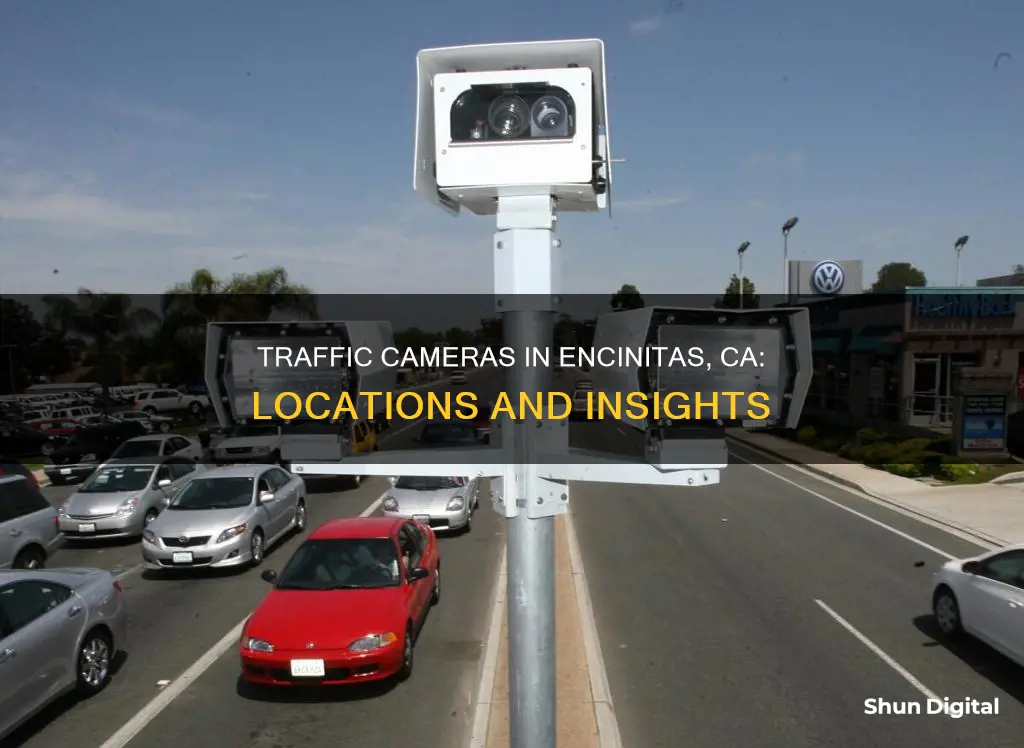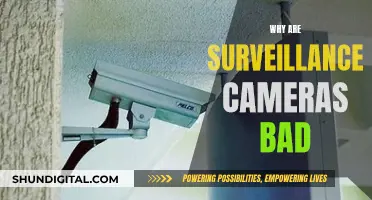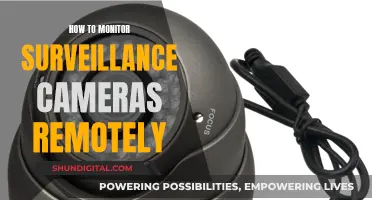
Traffic cameras are an increasingly common feature of modern life, and the city of Encinitas, California, is no exception. In December 2016, ten new surveillance cameras were installed at major intersections to help with traffic flow and improve public safety. These joined a network of seven existing street cameras that feed data back to the city's traffic operations center. However, in 2020, Encinitas ended its red-light camera program, which had been in place for around 15 years, citing limited benefits to accident prevention and high fines for drivers. This text will explore the implementation and impact of traffic cameras in Encinitas, CA, and the reasons for the city's decision to remove red-light cameras.
| Characteristics | Values |
|---|---|
| Number of Traffic Cameras | 10 new cameras added to the network of 7 existing cameras |
| Locations | El Camino Real, Encinitas Boulevard, Olivenhain Road, Leucadia Boulevard, Coast Highway 101, Vulcan Avenue |
| Purpose | Help with traffic flow and improve public safety |
| Operator | City's traffic operations center |
What You'll Learn
- Traffic cameras installed at major intersections
- Cameras help with traffic flow and public safety
- Cameras are linked to the city's traffic operations centre
- Cameras are set up to monitor traffic flow only and do not issue tickets
- Red-light cameras capture photographic evidence of red-light runners for ticketing purposes

Traffic cameras installed at major intersections
In December 2016, ten new traffic cameras were installed at major intersections in Encinitas, California. The cameras are part of a fibre optic infrastructure project that was approved in 2012 and are set up at busy intersections along El Camino Real, Encinitas Boulevard, Leucadia Boulevard, Coast Highway 101, and Vulcan Avenue. The new cameras are tied to a network of seven existing street cameras that send data back to the city's traffic operations centre.
At the traffic operations centre, traffic engineering specialists monitor the feeds and traffic conditions. They can then adjust the street lights to help with traffic flow and alert police and first responders in the event of accidents and emergencies.
The city of Encinitas had two sets of cameras at two El Camino Real intersections. One set was at Encinitas Boulevard, installed in 2005, and the other was at Olivenhain Road and Leucadia Boulevard, installed in 2004. However, in May 2020, the city decided not to renew its contract with the camera provider, Redflex, ending a 15-year program. The decision was made based on the limited accident-prevention benefits provided by the cameras and the high cost of the associated fines.
Autopilot Vision: Tesla Cars' Camera Technology Explained
You may want to see also

Cameras help with traffic flow and public safety
The new cameras were part of a fiber-optic infrastructure project approved in 2012. They were connected to a network of seven existing street cameras that send data back to the city's traffic operations center. Here, traffic engineering specialists monitor the feeds and traffic conditions. They can then adjust the street lights to improve traffic flow and alert the police and first responders to accidents and emergencies.
The cameras are beneficial for public safety as they can help to prevent accidents and improve the efficiency of emergency responses. For example, Kirk Bell, owner of a hair salon on the corner of E Street and Coast Highway 101, noted that traffic is a significant problem along the highway, and he has witnessed many serious accidents. The cameras are also useful for monitoring the flow of traffic and can help to reduce congestion.
However, there has been some opposition to the use of cameras in Encinitas. In May 2020, the city decided to end its red-light camera program, which had been in place for 15 years. The program used sets of cameras at two El Camino Real intersections to collect photographic evidence of red-light runners for ticketing purposes. The decision to end the program was made due to concerns about the limited accident-prevention benefits and the high cost of fines.
License Plate Cameras: Can They Issue Tickets?
You may want to see also

Cameras are linked to the city's traffic operations centre
In December 2016, the city of Encinitas, California, installed 10 new traffic cameras at major intersections to help alleviate congestion and improve public safety. These cameras are linked to the city's traffic operations centre, where specialists monitor the feeds and traffic conditions. The cameras are part of a fibre optic infrastructure project that was approved in 2012 and are set up at busy intersections along El Camino Real, Encinitas Boulevard, Leucadia Boulevard, Coast Highway 101, and Vulcan Avenue.
The new cameras tie into a network of seven existing street cameras that relay data back to the traffic operations centre. This allows specialists to have a comprehensive view of traffic conditions in the city and make real-time adjustments to improve flow. For example, they can change street lights at the touch of a button to help ease congestion and alert first responders in the event of accidents or emergencies.
The city of Encinitas has previously used cameras to monitor traffic and enforce road rules. In 2020, the city ended its contract with camera provider Redflex, which had provided cameras at two El Camino Real intersections—one at Encinitas Boulevard and the other at Olivenhain Road and Leucadia Boulevard. These cameras collected photographic evidence of red-light runners for ticketing purposes, with fines set at $490. However, the program was criticised for providing limited accident prevention benefits and issuing fines for minor infractions such as incomplete stops during right turns.
Despite some opposition, the city opted not to renew the contract, citing the limited effectiveness of the program and the potential for reduced traffic due to the coronavirus pandemic as reasons for the decision.
Transferring Camera Photos: A Guide to Computer Importing
You may want to see also

Cameras are set up to monitor traffic flow only and do not issue tickets
Traffic cameras are a common feature in many cities, and Encinitas, CA, is no exception. These cameras are typically installed to monitor and manage traffic flow, and while they may resemble red-light cameras, they serve a different purpose and do not issue tickets. In fact, red-light cameras are located on the side or corner of an intersection, whereas traffic cameras are usually positioned on top of the traffic light.
In the past, Encinitas utilised red-light cameras at two major intersections along El Camino Real: one at Encinitas Boulevard and the other at Olivenhain Road and Leucadia Boulevard. These cameras were used to capture photographic evidence of red-light runners for ticketing purposes, with fines set at $490 per ticket. However, in May 2020, the city decided not to renew its contract with the camera provider, Redflex, bringing an end to the 15-year-old program. This decision was made due to the limited impact on accident prevention and the high number of fines issued.
Instead of relying solely on red-light cameras, Councilman Joe Mosca suggested that the city should focus on making intersection changes, such as increasing the duration of yellow lights, to improve traffic flow and safety. This suggestion was met with some opposition, with Councilman Tony Kranz arguing that extending the yellow duration would not deter drivers from running red lights.
While red-light cameras are no longer in use in Encinitas, the city has installed additional traffic cameras to monitor traffic flow and improve public safety. In 2016, ten new surveillance cameras were set up at busy intersections along El Camino Real, Encinitas Boulevard, Leucadia Boulevard, Coast Highway 101, and Vulcan Avenue. These cameras are part of a fibre optic infrastructure project and are linked to a network of existing street cameras that feed data back to the city's traffic operations centre.
This centralised system allows traffic engineering specialists to monitor multiple intersections simultaneously and make real-time adjustments to street lights, improving traffic flow and enabling quicker responses to accidents and emergencies. The cameras do not identify individual vehicles or issue tickets; instead, they provide a comprehensive view of traffic conditions to assist specialists in making data-driven decisions.
The Ultimate Battery Pack Guide for Photographers
You may want to see also

Red-light cameras capture photographic evidence of red-light runners for ticketing purposes
The red-light camera program in Encinitas has been the subject of debate among city officials and residents. Some argue that the cameras provide limited accident prevention benefits and impose hefty fines on drivers. Others believe that the cameras are necessary for enforcing traffic laws and improving public safety.
The cameras are typically installed on the side or corner of an intersection and are distinct from traffic cameras, which monitor traffic flow and are usually located on top of traffic lights.
In 2020, the Encinitas City Council voted to end the red-light camera program, citing the limited benefits and high fines as reasons for their decision. However, law enforcement officials, such as the county Sheriff's Department, have supported the use of red-light cameras as an effective way to capture traffic violations.
The termination of the red-light camera program in Encinitas reflects a broader trend in San Diego County, with several other cities also choosing to discontinue their camera programs.
Turning Off Your Computer Camera: A Step-by-Step Guide
You may want to see also
Frequently asked questions
There are traffic cameras at major intersections throughout Encinitas, including along El Camino Real, Encinitas Boulevard, Luecadia Boulevard, Coast Highway 101, and Vulcan Avenue.
The traffic cameras in Encinitas are meant to help with traffic flow and improve public safety. They are tied to a network that relays data back to the city's traffic operations center, where specialists can monitor traffic conditions and make real-time adjustments to street lights to alleviate congestion.
Yes, there used to be red-light cameras at two El Camino Real intersections — one at Encinitas Boulevard and the other at Olivenhain Road and Leucadia Boulevard. However, as of May 2020, the city decided not to renew the contract with the camera provider and the red-light camera program was terminated.
Yes, as of May 2020, Del Mar and Solana Beach were the other two cities in San Diego County that still used red-light cameras.







